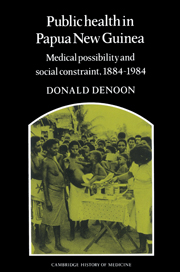Book contents
- Frontmatter
- Contents
- Acknowledgements
- Maps of Papua New Guinea
- Introduction
- I The rise and fall of tropical medicine
- 1 Pre-colonial health and disease
- 2 The administration of public health
- 3 Early colonial medical administration
- 4 The political economy of health in Papua between the wars
- 5 The political economy of health in New Guinea between the wars
- 6 Medical education
- 7 The Pacific War: the condition of the people
- II The rise and fall of the great campaigns
- Notes
- Bibliography
- Index
1 - Pre-colonial health and disease
Published online by Cambridge University Press: 11 February 2010
- Frontmatter
- Contents
- Acknowledgements
- Maps of Papua New Guinea
- Introduction
- I The rise and fall of tropical medicine
- 1 Pre-colonial health and disease
- 2 The administration of public health
- 3 Early colonial medical administration
- 4 The political economy of health in Papua between the wars
- 5 The political economy of health in New Guinea between the wars
- 6 Medical education
- 7 The Pacific War: the condition of the people
- II The rise and fall of the great campaigns
- Notes
- Bibliography
- Index
Summary
The context of this enquiry is the health of the people of Papua New Guinea, and its transformation over time. Regrettably, health is largely a subjective condition – ‘well-being’ is how we actually experience it: a contented condition which includes the absence of infection but is also a positive state. A study of health therefore cannot proceed directly: instead it relies upon inference. One source of evidence is the behaviour and observations of medical specialists, who are essentially experts in ‘ill-being’ rather than health itself. To compound the problem, we know very little about those specialists in pre-colonial Papua New Guinea. A recent review confesses that ‘next to nothing is known empirically about the medical botany of Papua New Guinea. Even less is known about the full diagnostic and treatment regimes available traditionally.’
In order to establish some base-line for this study, therefore, we have to make even more tenuous inferences from the physical environment. Since the physical environment itself changes, and human beings both change it and adapt to it, this overview cannot pretend to completeness. Such evidence as we possess is best considered as the dozen surviving pieces of a vast jigsaw puzzle: they can only suggest the scale and tone of the whole picture.
The outline of New Guinea's environmental history is now fairly clear. About 10,000 years ago, as the most recent ice-age receded and released water to swell the oceans, Torres Strait was submerged, separating New Guinea from the Australian continent, and stretching the intervals between the islands of the western Pacific.
- Type
- Chapter
- Information
- Public Health in Papua New GuineaMedical Possibility and Social Constraint, 1884–1984, pp. 9 - 17Publisher: Cambridge University PressPrint publication year: 1989



